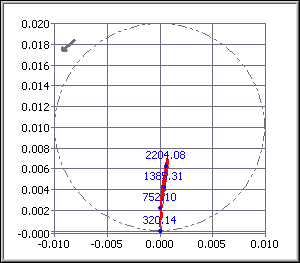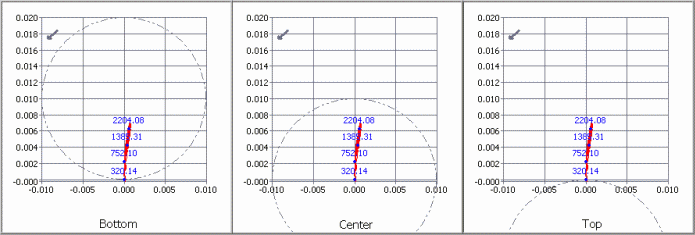1. The following comments apply to a the application of machinery protection and asset management systems for rotating machinery with hydrodynamic or fluid film bearings. The extent to which various parameters are recommended to be measured (and monitored) is directly proportional to how critical the machinery asset is to the continued, uninterrupted operation of the plant or process. For example, some machines such as turbine generators, compressors, and larger mechanical drive steam turbines, are found in the critical paths of many plant processes. Other types such as small motors, pumps and fans are non-critical or semi-critical machines. Therefore, the recommendations for monitoring compressors will generally be more rigorous and extensive than those for fans. Machine measurements must be correlated with process variable measurements in order to obtain a complete understanding of machinery behavior as well as providing adequate machinery protection.
2. The bearing type plays an important role in determining what the appropriate transducer suite should be. For example, semi-critical or non-critical machinery with rolling element bearings are usually adequately monitored via a single seismic transducer mounted radially at each bearing. Rolling element bearings have little or no damping which usually results in good transmissibility of the rotor’s vibration to the casing and due to the mechanical nature of the bearing itself, when it fails inevitably the vibration amplitude will increase. However, this is not the case for turbomachinery with hydrodynamic (fluid film) bearings. In order to properly monitor critical turbomachinery operating in hydrodynamic or fluid film bearings the shaft relative measurement utilizingproximity (displacement) probes must be a part of a properly engineered offering. XY (orthogonal; i.e. at 90°) proximity probes at each radial bearing are mandatory. There are no exceptions to this rule. From an engineering principle / best practices perspective it would not be acceptable to only use one proximity probe as opposed to installing two proximity probes, orthogonally mounted (90° apart). If only one probe is installed, dyanmic motion (vibration) will only be seen in the same plane as the longitudinal axis of the installed probe; i.e. in line with the transducer.
3. Reminding ourselves of the 1st Law of Machinery Diagnostics which states that Displacement = Force / Stiffness we recognize:
i. If the force (a vector quantity) changes, the displacement (also a vector quantity) will change
ii. Likewise if the force remains constant, but the stiffness (also a vector quantity) changes, the displacement will change
4. Let’s focus on the second item for just a moment. In the presence of a constant force due to unbalance[1] and an asymmetrical support stiffness[2] which exists with most turbomachinery, we realize that the resulting vibration displacement will vary as the constant unbalance force rotates and encounters a continually varying, asymmetric support stiffness. If we were to plot this motion, we would generate an elliptical shape; i.e. the shaft relative orbit, which would accurately depict the motion of the centerline of the shaft in the radial or xy plane. Maximum vibration will occur along the major axis of the ellipse (plane of lowest support stiffness) while along the minor axis of the ellipse, the vibration response will be at its minimum because the support stiffness is maximum. More than likely, the major axis of the ellipse (plane of maximum shaft vibration) will not be aligned with either the x or y proximity probe. Consequently by itself, as a single plane measurement, neither probe will see the maximum vibration. However, it can be observed by noting the vibration amplitude along the major axis of the ellipse or by calculating Smax. However, in order to either generate the shaft relative orbit or calculate Smax, xy transducers must be installed at 90°. These measurements cannot be made with a single plane measurement. The worst case scenario occurs when the major axis of the ellipse (plane of maximum vibration) is rotated 45° with respect to the angular location of the proximity probe. For this case, the proximity probe will only see 71% of the maximum vibration because the plane of maximum vibration is rotated 45° from the axis of the transducer.
5. The following vibration signal characteristics are critical when evaluating the health of turbomachinery operating in hydrodynamic bearings:
· overall vibration amplitude
· vibration frequency
· filtered vibration amplitude; i.e. 1X, 2X, nX (requires once per turn phase trigger probe as a phase reference)
· determining actual maximum vibration amplitude (requires xy proximity probes)
· shape or form of the vibration, i.e. orbit (requires xy proximity probes)
· vibration precession; vibration either in the direction of or opposite of the direction of rotation (requires xy proximity probes)
· rotor operating deflection and / or mode shape (requires xy proximity probes)
· shaft average centerline radial position (requires xy proximity probes)
· identification and evaluation of support stiffness asymmetry (requires xy proximity probes)
· full spectrum (requires xy proximity probes)
· Smax vibration amplitude (requires xy proximity probes)
6. It should be noted that the selection of any transducer / monitoring / protection / information system often involves compromises. There is a point that must be made at this time. There are no absolutes and there is no one machinery protection or management system that is adequate or capable of detecting any and all machinery malfunctions or potential failures. The recommendations offered here apply universally to the most common design configurations and process applications, but as with any general set of rules, there will be exceptions. There always is and always will be a trade-off between the complexity of the transducer suite / monitoring and / or information systems and the economic justification for enhanced performance of the protection / information system. The technical priorities are weighed against the economic considerations and a decision is made.
7. In general, it is important to recognize that in order to determine the optimum protection system for any turbomachinery train, each piece of machinery must be evaluated individually. Often adequate data is not available for a detailed analysis of a particular machine's expected behavior under normal and malfunction conditions. It then becomes necessary to use sound engineering principles in order to “install what is right” as opposed to “install what is easy”.
8. End users should fully understand the value of the information that the transducer suite / vibration monitoring system is providing to them and how to turn this information into productive tasks and actions. At times, end users are not aware of the total information that is available from a properly engineered, installed, and commissioned transducer suite / machinery protection system. Having the correct information at the right time is mandatory in order to properly manage units in order to achieve the desired unit availability goals, mitigate risk, and better plan for upcoming outages.
9. A good tool to use to evaluate where you are is a “risk assessment”. It starts with a careful evaluation of all relevant data to determine current status, where the end user wants (or needs) to go, and what needs to be done so that the end user can achieve the established goal(s). One deliverable from the risk assessment is a prioritized action plan. This action plan should communicate whether the current transducer suite / machinery protection system(s) is adequate.
At a minimum, the risk assessment should include:
• A review of current business objectives and contractual obligations.
• Quantify past and present unit performance, maintenance history, and unit availability.
• Review and quantify previous operational, maintenance and machinery failures and their impact on unit availability.
• Review existing data relative to any previous failures, maintenance history and unit availability.
• Evaluate current system status and capabilities.
• Quantify expected return on investment of expected changes or improvements.
_________________________________________________________________________________
[1] A fixed mass at a fixed radius rotating at operating speed generating a constant, uniform force in all directions
[2]Nnon-uniform support stiffness; i.e. different vertical support stiffness vs. horizontal stiffness.








